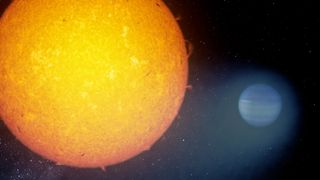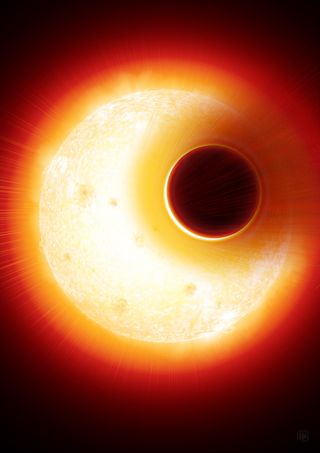A Helium Tail Trails This Fluffy Alien Planet
As a Jupiter-size world swings around its small but active star, bombarded by radiation, the planet leaves behind a tail of escaping helium as wide as itself — and researchers have spotted this tail from the ground, 163 light-years away.
Since scientists first found planets around other stars, many of their most striking discoveries have come from off-Earth instruments like NASA’s Kepler and Hubble space telescopes. Kepler has identified more than 2,000 verified planets passing by their stars, while Hubble observations have helped scientists characterize exoplanet atmospheres. But two new papers published today (Dec. 6) in the journal Science pinpoint the movement of helium in alien atmospheres from the comfort of our home planet.
The two research teams both used a 3.5-meter (11 feet) telescope in Calar Alto, Spain, to make their measurements — taking advantage of the telescope's powerful CARMENES instrument (short for Calar Alto high- Resolution search for M dwarfs with Exoearths with Near-infrared and optical Échelle Spectrographs) to finely measure the action of helium surrounding the planets. [The Most Intriguing Alien Planet Discoveries of 2017]

"This is the first time we can actually observe a helium tail," Lisa Nortmann, lead author on one of the new papers and a researcher at Instituto de Astrofísica de Canarias (IAC) in Spain, told Space.com. In their new paper, Nortmann's group looked for helium in the outer atmospheres of multiple planets. And one, called WASP-69b, showed a particularly dramatic effect.
"Before, it was assumed that if helium is in the [outermost atmospheric layer of a] planet, it might escape and form a tail. That was based on models, but this is the first time we can actually observe it while it's still in front of the star, when the planet is not in front of the star anymore," she said. Though WASP-69b is about the size of Jupiter, she said, it has the mass of Saturn, meaning it's lighter and fluffier than any of our solar system's planets.
The second group of researchers focused on a Neptune-size world, which shows an outer atmosphere full of speedy helium atoms being blasted away by the host star's high-energy radiation. Researchers modeled the atmosphere based on their observations to determine whether this helium was escaping the planet.
Get the Space.com Newsletter
Breaking space news, the latest updates on rocket launches, skywatching events and more!
Twenty years ago, researchers hypothesized that a distinctive wavelength of near-infrared radiation absorbed by helium when light passes through the gas could be used to track the element in distant atmospheres, Nortmann said. But only recently have spectrographs, which measure wavelengths of light, become precise enough to pinpoint helium in that situation. And because of that, ground telescopes have an unexpected advantage.
"From the ground we are able to see Mars with our bare eyes; we can say it is there but not much more," Nortmann added by email. "If we send a spacecraft, however, we can resolve its surface at high resolution and learn things. Now, we have exactly the opposite case — from the ground we can say much more about the escaping helium because the instrumentation offers higher resolution in wavelength and also in time."
The Carmenes spectrograph can finely measure the wavelength absorbed, which shows when the helium atmosphere is in front of the star and the speed the helium is moving toward Earth — because light turns bluer when it's headed toward us. This measure tells the researchers if the helium is moving fast enough to escape from the planet. Escaping exoplanet atmospheres are typically measured using an ultraviolet wavelength of light associated with hydrogen, but because ultraviolet light is absorbed by Earth's atmosphere, it can be measured only by space telescopes. (It is also absorbed by the interstellar medium and so can be harder to detect.) While Hubble can also detect helium, the resolution of its measurement is not as good.
"This is a very strange case where ground-based telescopes really beat the space telescopes," Enric Palle, a co-author on the study also from IAC, told Space.com. "And we can get an awful lot of information that we cannot get from Hubble."
"There is a feature which is extremely strong ... that is telling us a lot about how atmospheres of [some] exoplanets evolve with time, the ones that have an envelope of hydrogen and helium and are close to a star emitting a strong flux in the UV," he added.
Palle noted that, at the rate the helium is disappearing, the planet may dwindle but will likely not evaporate entirely during the star's lifetime. By studying WASP-69b and others like it, scientists can begin to understand how gaseous planets lose their atmospheres — and how some of these worlds, potentially, become rocky planets. (However, that's unlikely to happen with this world.)
Jessica Spake, a researcher at the University of Exeter in England and co-author of the second paper, said of her group's observation of the Neptune-size world, "This is a really exciting discovery, particularly as helium was only detected in exoplanet atmospheres for the first time earlier this year." Spake's group made that earlier detection using Hubble, though the group's newly published research used the CARMENES spectrograph on the ground.
"The observations show helium being blasted away from the planet by radiation from its host star. Hopefully, we can use this new study to learn what types of planets have large envelopes of hydrogen and helium and how long they can hold the gases in their atmospheres," Spake said in a statement.
"In general, [these papers show] extremely interesting detections of helium," Giovanna Tinetti, a researcher at University College London who is the principal investigator on the European Space Agency's upcoming ARIEL space telescope and was not involved in these studies, told Space.com. "Of course, these are detections of single planets; it would be great to see what other variations [arise] if you compare different planets, and so I'm looking forward to seeing more detections in the future so we can start a comparative study among all the planets. [Helium is] a very, very important species to detect in atmospheres, so it's really very thrilling."

"I think space and ground are extremely complementary, and ideally we really want to have both, because there are some things that you can't do from the ground, you need space, and vice versa," Tinetti added. "And this is a perfect example of that."
From space, she said, you can see the broad spread of wavelengths emitted by different planets to get an overall view of a planet's atmosphere. "But from space, of course, most instruments are smaller compared to what you can do from the ground, and so if you're interested in something that is weak in terms of absorption features or very sharp, you're better off on the ground," Tinetti said. "From the ground, you can't really look at all the wavelengths, because as you know you have your atmosphere between you and the observations, so in that sense you're more limited in terms of wavelength coverage. But you have the opportunity whenever you have some window to go for single, very sharp features. Ideally, you really want to have both."
Looking forward, Palle sees ground spectrographs as a vital tool for characterizing exoplanet atmospheres.
"I think this is what will happen also as a general case for atmospheres of extrasolar planets [with] the coming of the extremely large telescopes, the TMT [Thirty Meter Telescope], the GMT [Giant Magellan Telescope] and the ELT [Extremely Large Telescope]," Palle said. These instruments "will have enormous collecting areas, will be able to take advantage of these techniques and will be able to explore the atmosphere of Earth-size planets."
Even though those telescopes will be looking through Earth's atmosphere, he said, with a high-enough resolution on the spectrograph, researchers will be able to distinguish water vapor and oxygen on an exoplanet, for instance, from such substances in our own atmosphere, all based on very fine details in the measured spectrum. A telescope like the ELT could measure atmospheres on rocky planets in the TRAPPIST-1 system, for example, to look for oxygen, water vapor and carbon dioxide over just five nights of observation, he said.
"In 10-15 years, plus or minus five years, the ELTs will be ready, these instruments will be at the telescope and they will have the power to detect the composition of those rocky planets," Palle said. "And then we may have to interpret, well — I found water and oxygen; is this planet inhabited or not? But we will have the power to detect the signatures of those gases in rocky planets."
Email Sarah Lewin at slewin@space.com or follow her @SarahExplains. Follow us on Twitter @Spacedotcom and on Facebook. Original article on Space.com.
Join our Space Forums to keep talking space on the latest missions, night sky and more! And if you have a news tip, correction or comment, let us know at: community@space.com.

Sarah Lewin started writing for Space.com in June of 2015 as a Staff Writer and became Associate Editor in 2019 . Her work has been featured by Scientific American, IEEE Spectrum, Quanta Magazine, Wired, The Scientist, Science Friday and WGBH's Inside NOVA. Sarah has an MA from NYU's Science, Health and Environmental Reporting Program and an AB in mathematics from Brown University. When not writing, reading or thinking about space, Sarah enjoys musical theatre and mathematical papercraft. She is currently Assistant News Editor at Scientific American. You can follow her on Twitter @SarahExplains.
